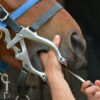Strangles in horses are among the most common equine diseases that affect horses worldwide. Over 600 outbreaks occur in the UK alone each year. Being the most infectious disease, Strangles can affect any age, breed, and gender of horse. As such, any horse owner needs to be aware of the disease, the symptoms, and how treatment of Strangles in horses is done. If the horse’s behavior looks suspicious to you, do not hesitate to call the equine experts.
What is Strangles?
Strangles is an infectious disease caused by a bacteria called Streptococcus equi subspecies equi, or Strep. Equi, in short.
It affects a horse’s upper respiratory tract. This happens when the bacteria travel to the mucous membranes in the nose and mouth; finally infecting the lymph nodes where they cause abscesses, which will eventually rupture. The infected lymph nodes become swollen that compresses the upper respiratory tract.
In other words, quite literally “strangling” the horse.
Why Are Horses So Susceptible To It?
The most common age range where horses exhibit signs of Strangles is between 6 to 10 years of age. Horses quickly become infected through the ingestion or inhalation of the bacterium, which is why the treatment of Strangles in horses takes much longer.
Due to its infectious nature, horses contact Strangles through different mediums: horse-to-horse contact, unhygienic material or infected equipment, or by drinking contaminated water.
The severity of this disease varies and entirely depends on the horse’s immune status. That’s why younger horses seem to show more severe clinical signs, whereas older horses are much less severely affected.
Like every other disease, the sooner the diagnosis is completed, the better. Uncomplicated cases of Strangles in horses within the UK often recover fully. Even if some cases escalate, (which happens in 10% of cases in general), the disease has a mortality rate of about 40%.
However, some horses(about 10%) can become chronic carriers following infection and recovery. Horses who become carriers carry a small percentage of the bacteria in their guttural pouches in the form of chondroid, which are dried pus. One of the concerning issues is that these very carriers intermittently shed the bacteria, so they’re essentially creating a reservoir of chronically infected animals in the long term.
To prevent spreading this in your yard, consult with a professional equine vet today!
What Happens Once A Horse Ingests/Inhales The Bacteria?
The incubation period for Strangles lies between 3-8 days. Clinical signs may appear throughout the period, including swollen lymph nodes, abscess formation, severe nasal discharge, fever, anorexia, and lethargicness.
The first sign of Strangles may appear after 2-3 days of the infection, abrupt onset of fever (over 103℉). It often leads to nasal discharge several days later. Painful lymph nodes may appear one week after infection.
Over time, the lymph nodes can enlarge and cause respiratory obstruction. This can later make it harder for the horse to breathe and swallow food properly, resulting in a loss of appetite. Whereas, when it comes to older horses or those exposed to the disease, the symptoms are limited to the upper respiratory signs with little to no lymph node abscesses. Treatment of Strangles in horses who are older is not as complicated and tend to recover faster as well.
Symptoms of Strangles in Horses
Although the symptoms are usually seen between 3-8 days after the horse has been exposed to the disease, it can take as long as 14 days to show. This can be seen when there is:
- A loss of appetite
- Difficulty swallowing
- Severe Nasal Discharge(often thick yellow or green)
- Dullness, lameness, and depression
- Coughing
- Fever
- Swelling of the lymph nodes lower down the neck or right under the jaw(usually visible after a week of the onset of clinical symptoms)
As mentioned before, some 10%, in general, have complications which are rare cases. However, they do happen, and the following are two scenarios:
- “Bastard Strangles” is one form of Strangles that can be highly difficult to treat. They cause abscesses in other areas of the body such as the intestines, brain, or lungs一, which can be fatal for the horse as it results in organ failure.
- “Purpura haemorrhagica” causes bleeding into the gums, skin and even organs such as the lungs, which is quite alarming.
Treatment Of Strangles In Horses
Treatment of Strangles in horses varies. Most of the time, the treatment is aimed at keeping the horse as comfortable as possible. Using anti-inflammatory drugs such as Bute (phenylbutazone) and draining the pus from the abscess helps a bit.
Afterwards, a guttural pouch endoscopy and nasopharyngeal swabbing should be performed at a minimum of 10 days when the onset of clinical signs has passed.
It goes without saying that individual treatment protocols have to be discussed with the veterinary surgeon. Treatment of Strangles in horses depends on the strict management of quarantining, minimising movements and disinfection.
The Diagnosis
Diagnosis of Strangles in horses is much more straightforward. It takes is a swab from the back of the horse’s nasal cavity or directly swabbing the abscess when it’s being drained.
One of the most challenging issues facing the veterinarians and the owners is when a horse has a nasal discharge without lymph node enlargement. A nasal discharge is associated with other less serious bacterial respiratory diseases. And it makes the diagnosis more tricky. However, if your horse developed a thick nasal discharge, we highly recommend immediate isolation until it’s safe. Also, take nasopharyngeal swabs to check for the Strangles bacteria.
If you have a new horse joining your yard, you can ask for specific blood tests that determine whether your new horse has been exposed to the bacterium. These blood tests can detect the antibodies that fight against the Strangles bacteria. This can be particularly useful for identifying carrier horses. And it helps assess which horses have been exposed to the bacteria during an outbreak.
However, you may try alternative ways to detect the disease when the symptoms are not visible. If there are no signs of nasal discharge, their blood samples taken 10-14 days apart can be tested. This way, you can see if there are any rising antibody levels indicating the level of exposure to the disease.
Prevention of Strangles in Horses
If you suspect a Strangles infection or an outbreak, it is imperative to separate the horses using a “traffic light” system and contact a professional:
- Red Group: Horses who were directly affected by the disease
- Yellow Group: Horses that were in contact with the infected horses
- Green Group: Horses that have not been in contact with either of the above
Each group should, of course, be in complete isolation. This isolation is a critical step in preventing the further spread of the disease.
Horse owners should be on alert and implement a strict quarantine strategy for new arrivals to the yard. The procedure is not just for Strangles but also for influenza, worming and parasites. You can also request a Strangles blood test before accepting a new horse to the premises. An additional blood sample can be requested at the end of the 14-day isolation period in some yards. It is easier for you to determine whether the horse carries an infectious disease.
In order to control an outbreak, a strong biosecurity management plan is very important. We recommend ensuring that such a plan is put into action in case of an outbreak. When that happens, rapid isolation of the infected and at-risk animals should be done without hassle.
A delay in this step could either mean months of strict isolation or movement restrictions. To ensure no such mistake happens, strict hygiene and biosecurity should be on top of the priority list in controlling the disease and preventing it from spreading.
Questions We Answer Before You Ask:
How to tell if your horse is a chronic carrier?
As mentioned before, approximately 10% of recovered horses become a carrier for the bacteria, where it’s stored in the guttural pouches. These horses are often symptom-free and appear to be okay, although their chances of spreading the disease are high enough already. They are symptom-free and can live amongst the population for months or even years. This is the reason why Strangles in horses is a widespread problem in the UK.
How to tell if your horse has an abscess?
These days, horse owners are so well in tune with how a horse behaves that anything out of the ordinary makes them suspicious, which is great. However, there are still some instances where owners think it’s just a common cold and don’t think more of it later on.
This can end up causing something severe. When it comes to Strangles abscesses, you’ll notice that your horse is getting feverish, lethargic, depressed and even losing its appetite due to the enlarged lymph nodes. Clinical symptoms of Strangles in horses last about 2-4 weeks and cause death, which is very rare(fewer than 2% in the population).
Are vaccines available for Strangles?
Yes!
A more effective vaccine is now available in the UK to help manage and prevent the disease. A submucosal injection can be administered to horses from four months of age into the upper lip. The initial dosage consists of two vaccinations given 4 weeks apart.
Conclusion
Strangles in horses is the most frequently diagnosed disease in the UK. Despite most of our efforts, these “silent” infectious diseases slip through our tightly knotted security barrier and get to our precious equine animals.
But, the future isn’t as bad as it may seem because, with advanced technology and science, researchers are constantly experimenting with creating better ways to detect the disease. With the help of the knowledge given above and a more excellent owner, Strangles’ spread won’t be as much of a problem.
To learn more about equine diseases and their symptoms, please visit here.








